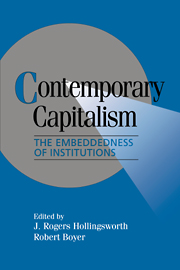Book contents
- Frontmatter
- Contents
- Acknowledgments
- List of Contributors
- Chapter 1 Coordination of Economic Actors and Social Systems of Production
- PART I THE VARIETY OF INSTITUTIONAL ARRANGEMENTS AND THEIR COMPLEMENTARITY IN MODERN ECONOMIES
- PART II HOW AND WHY DO SOCIAL SYSTEMS OF PRODUCTION CHANGE?
- PART III LEVELS OF SPATIAL COORDINATION AND THE EMBEDDEDNESS OF INSTITUTIONS
- PART IV CONCLUSION
- Index
PART III - LEVELS OF SPATIAL COORDINATION AND THE EMBEDDEDNESS OF INSTITUTIONS
Published online by Cambridge University Press: 05 June 2012
- Frontmatter
- Contents
- Acknowledgments
- List of Contributors
- Chapter 1 Coordination of Economic Actors and Social Systems of Production
- PART I THE VARIETY OF INSTITUTIONAL ARRANGEMENTS AND THEIR COMPLEMENTARITY IN MODERN ECONOMIES
- PART II HOW AND WHY DO SOCIAL SYSTEMS OF PRODUCTION CHANGE?
- PART III LEVELS OF SPATIAL COORDINATION AND THE EMBEDDEDNESS OF INSTITUTIONS
- PART IV CONCLUSION
- Index
Summary
“Capitalism is a moving target” could well be the leitmotif tot this entire volume. In Part I, not only did every essay stress the variety of capitalist institutions and the importance of explicit arrangements for coordinating exchanges and governing behavior, but they were all sensitive to changes in the mix of markets, hierarchies, associations, networks, state agencies, and corporatist arrangements over time. In Part II, an effort was made to aggregate these mixes into distinctive “social systems of production” and to specify the conditions for their emergence and subsequent evolution – again, with the objective of explaining persistent diversity across units and periods, not their imminent convergence.
Part III explores the significance of yet another potential source of variation within capitalism: space. In Parts I and II, as well as in Governing Capitalist Economies, the dominant technique of analysis involved comparisons according to function (or, more specifically, sectors of production and distribution) and time (or, more specifically, historical periods during which some relative equilibrium in the mix of governance mechanisms has set in).
The authors, implicitly or explicitly, limited their attention almost exclusively to the national level of spatial aggregation. Following a well-worn tradition in the social sciences, they seem to have assumed either that each nation tended to develop a culturally distinctive “style of capitalism” based on its peculiar human and material endowment, as well as historical experience, or that each state embodied a unique configuration of power and authority that was reflected in the creation and operation of its intermediary institutions.
- Type
- Chapter
- Information
- Contemporary CapitalismThe Embeddedness of Institutions, pp. 311 - 318Publisher: Cambridge University PressPrint publication year: 1997
- 4
- Cited by



